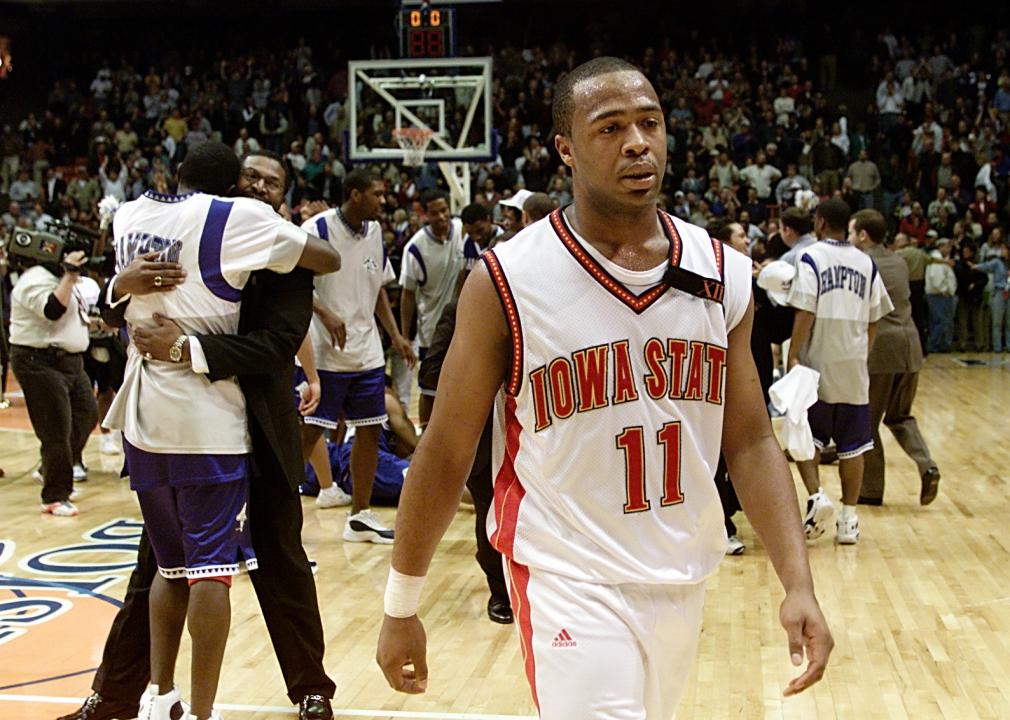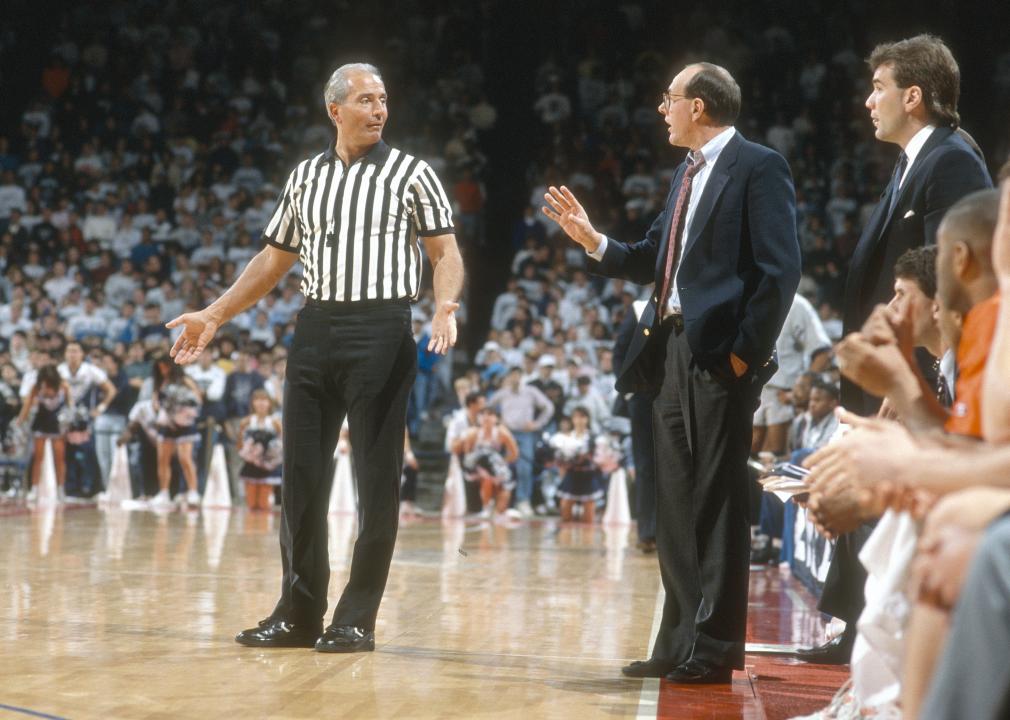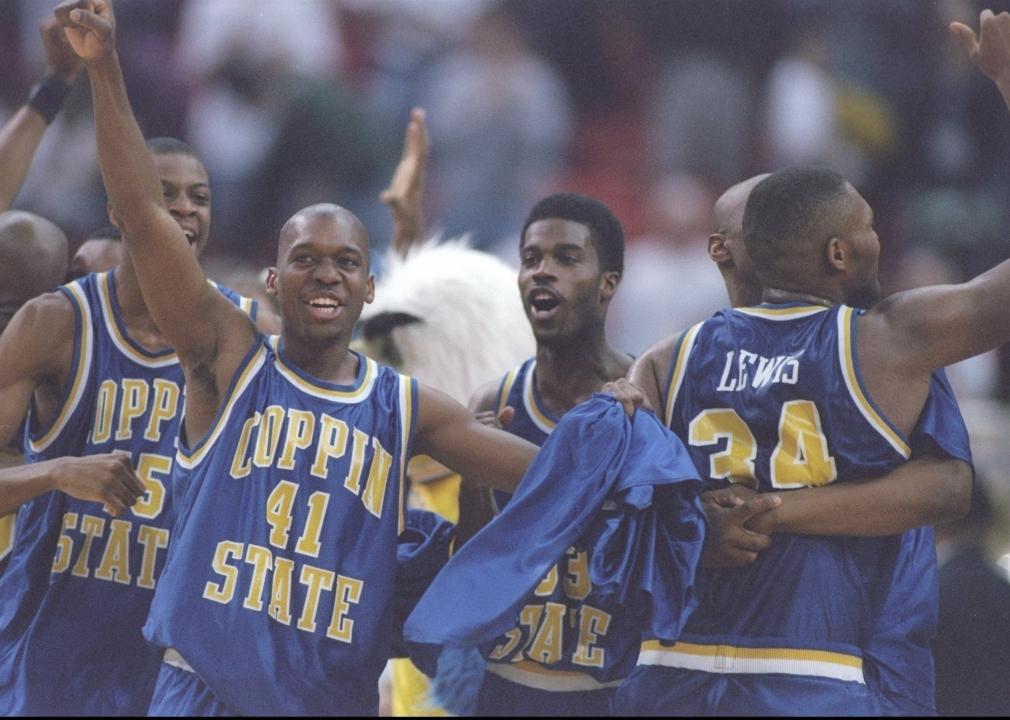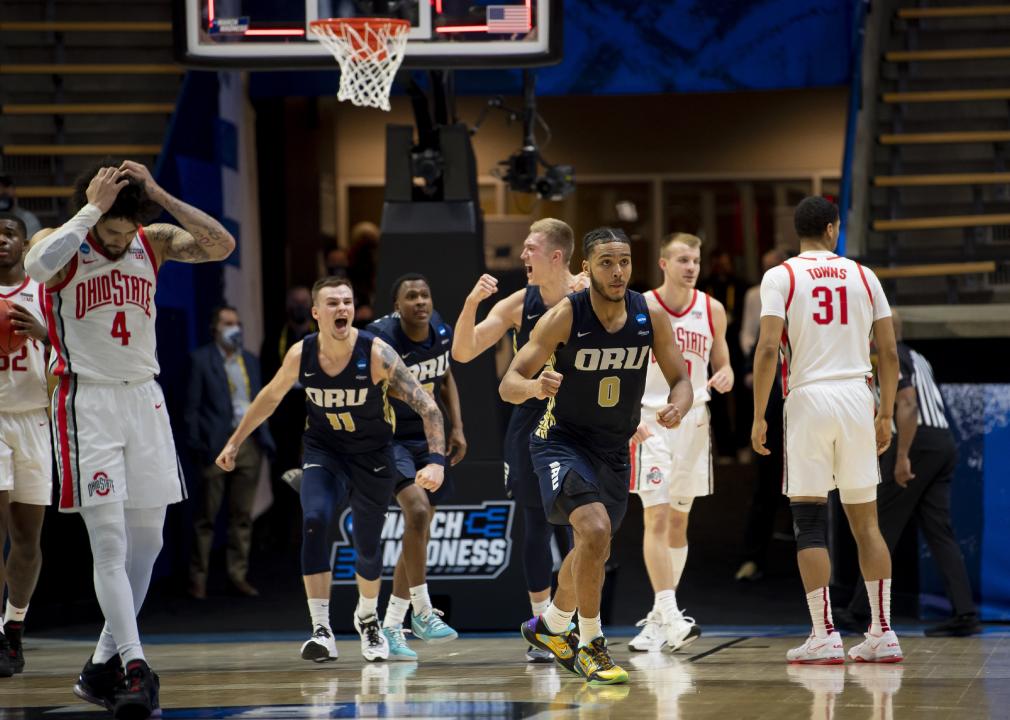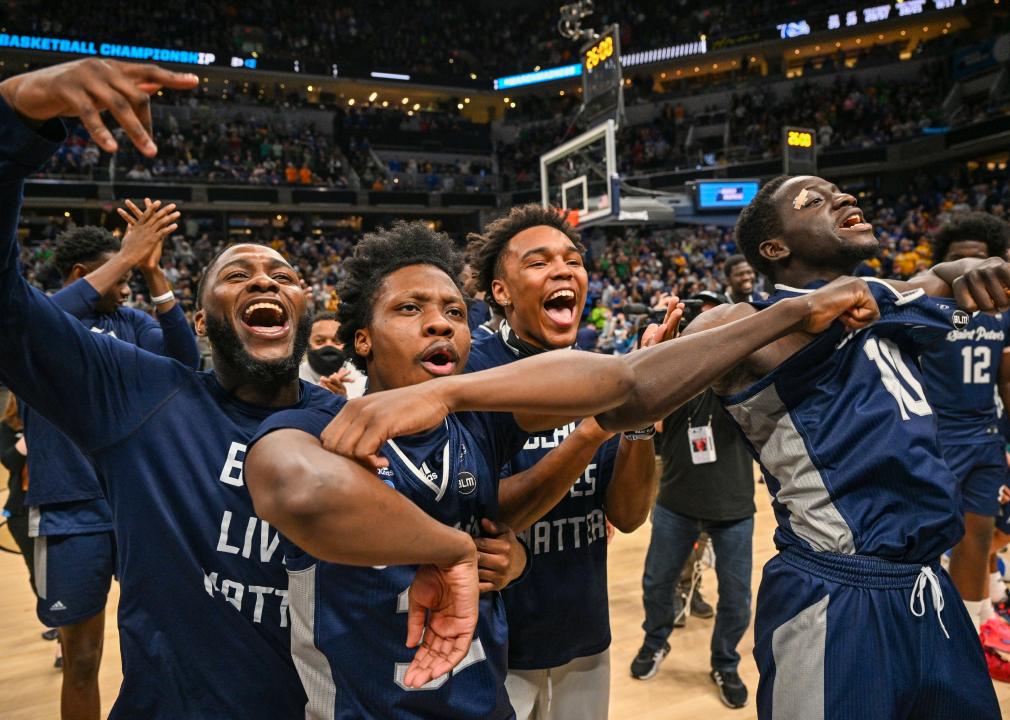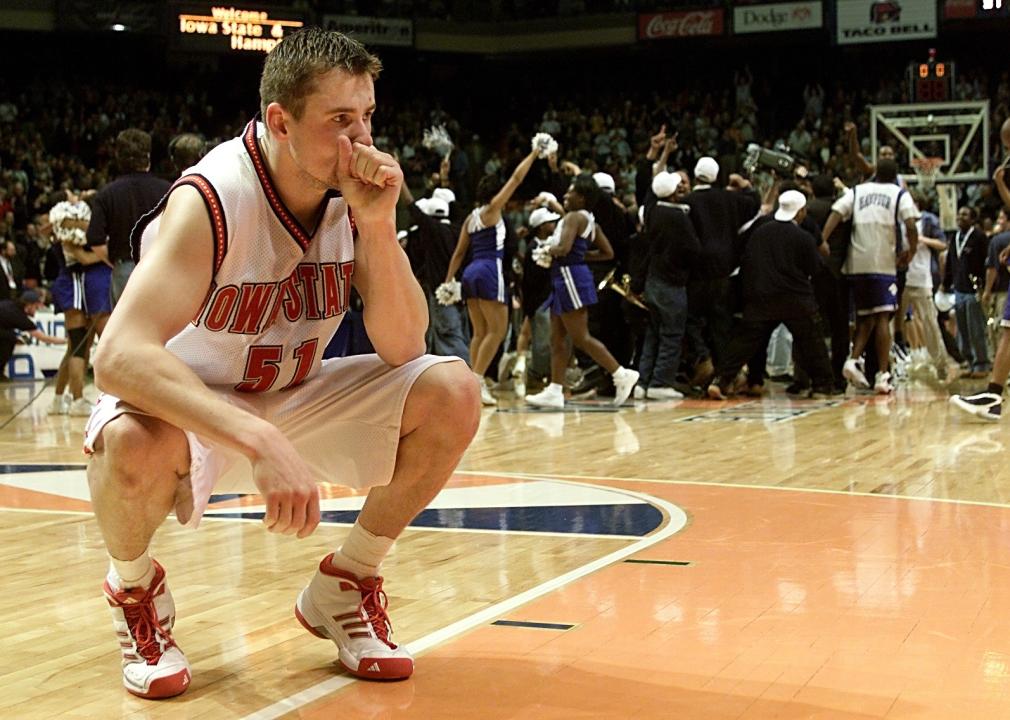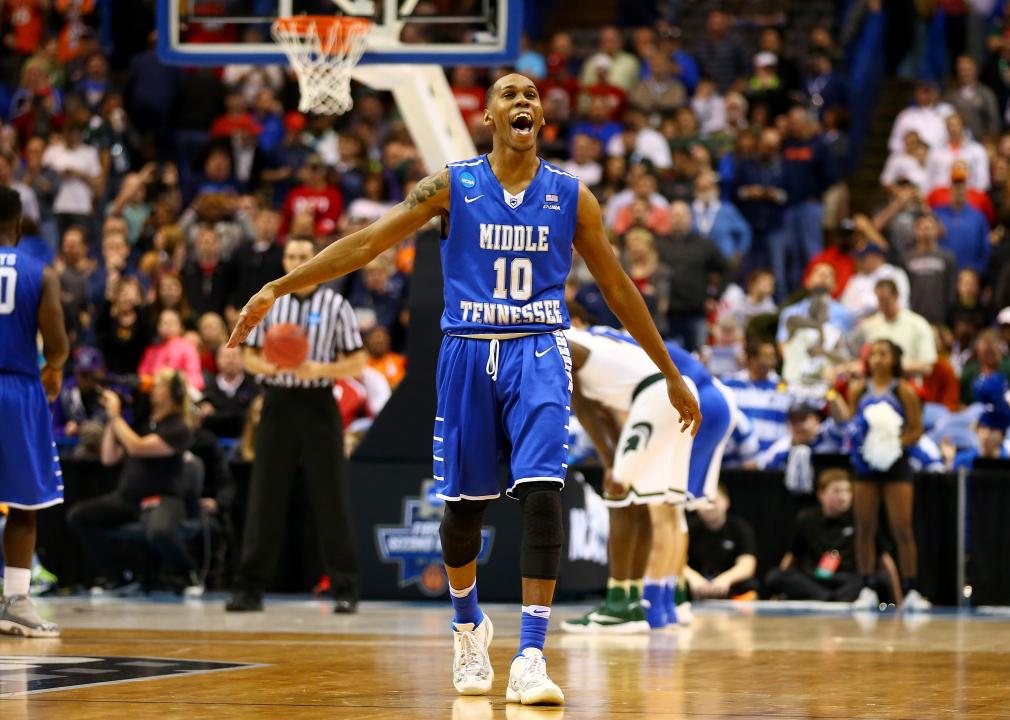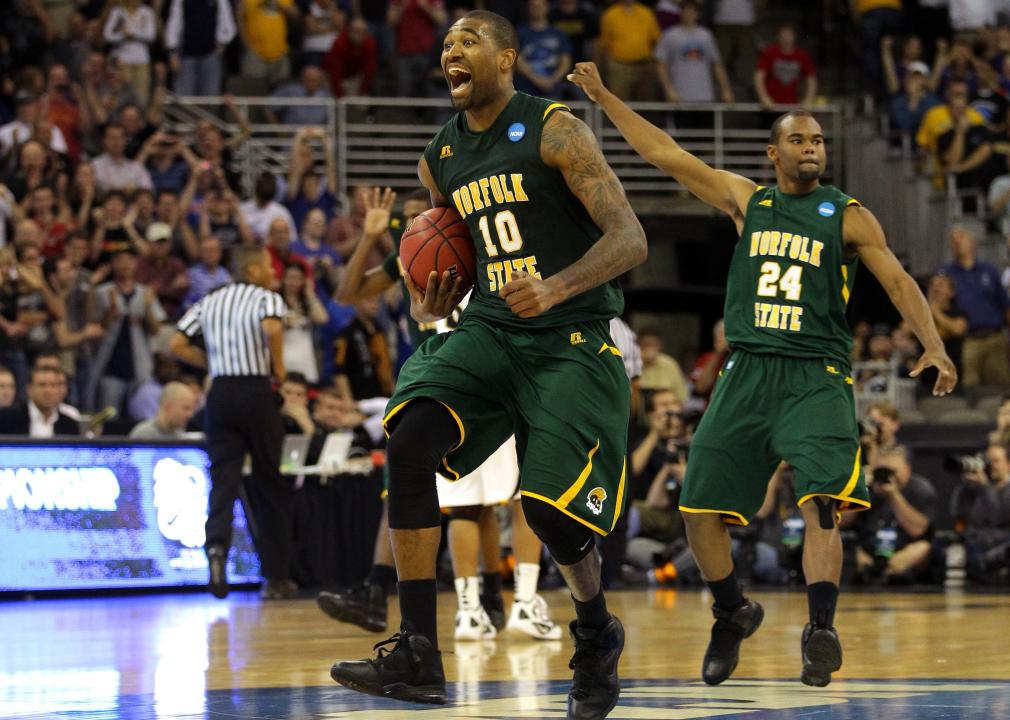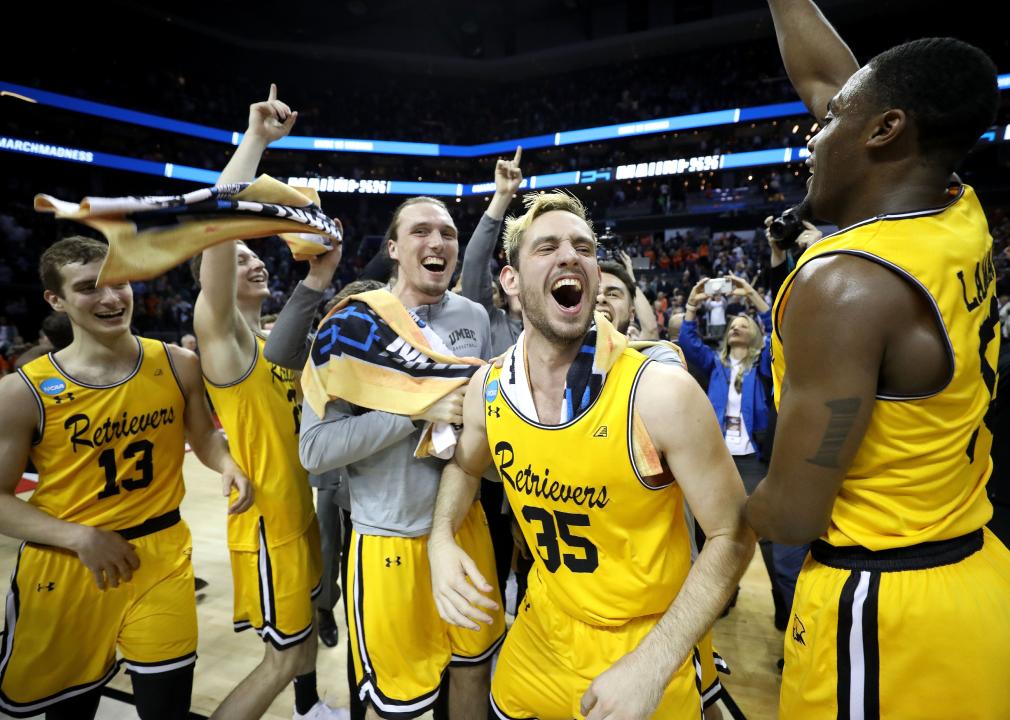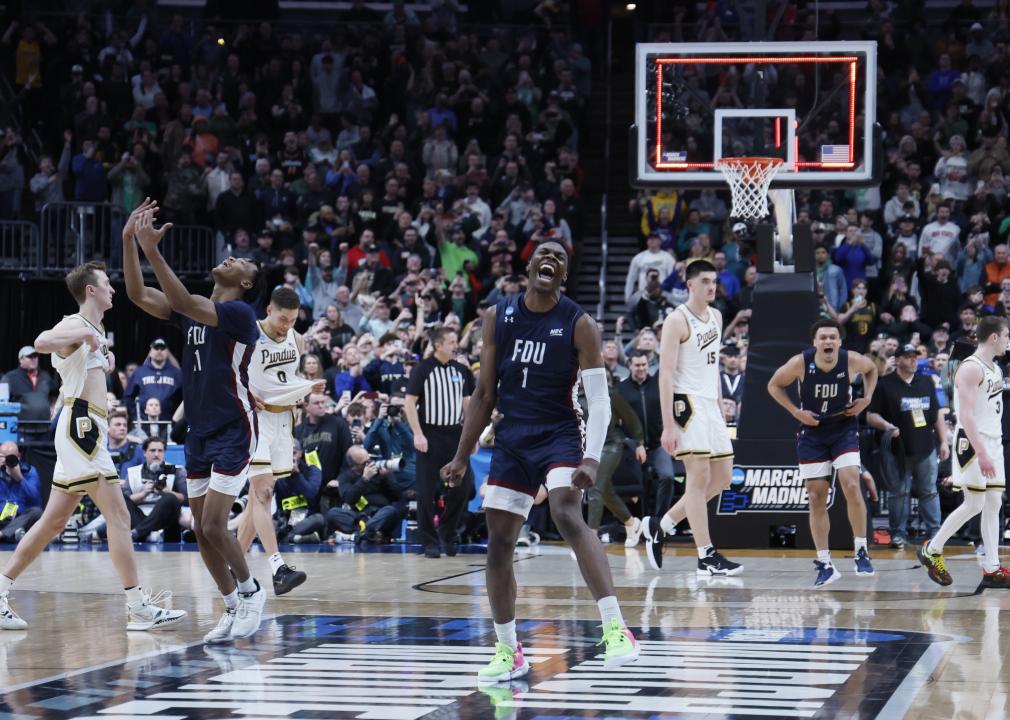Biggest March Madness upsets since 1982
Brian Bahr // Getty Images
Biggest March Madness upsets since 1982
Jamaal Tinsley walks off the court after the Hampton Pirates won 58-57 during the NCAA Tournament.
Every year, sports fans are consumed with March Madness and the thrill of the upsets that make—or break—their brackets.
Television commentator Brent Musburger wedded the NCAA tournament with the moniker during the 1982 men’s edition, describing upsets with a phrase used for Illinois’ state high school basketball tournament. It stuck, and now, every year, amateur bracketologists try to predict which teams will author Cinderella stories by taking down the big programs in the bracket.
March Madness matchups rely on seeding. To get into the Big Dance, a team must win its postseason conference tournament or be one of the 36 best at-large teams, as determined by the selection committee.
The NCAA divides the 68 teams into four regions, with each group ranked from #1 to #16 based on several factors, including their performances during the regular season and postseason tournaments. Since full seeding began in 1979, the NCAA has yet to complete the impossible task of sorting teams accurately, as every year has featured multiple upsets.
ATS.io compiled a ranking of the biggest men’s March Madness upsets since 1982 using Sports Reference data. Upsets were defined as wins by teams seeded five or more slots lower than their opponents and ranked according to seed difference. The difference between the squads based on Sports Reference’s simple rating system, which rates teams based on average point differential and strength of schedule, broke ties.
![]()
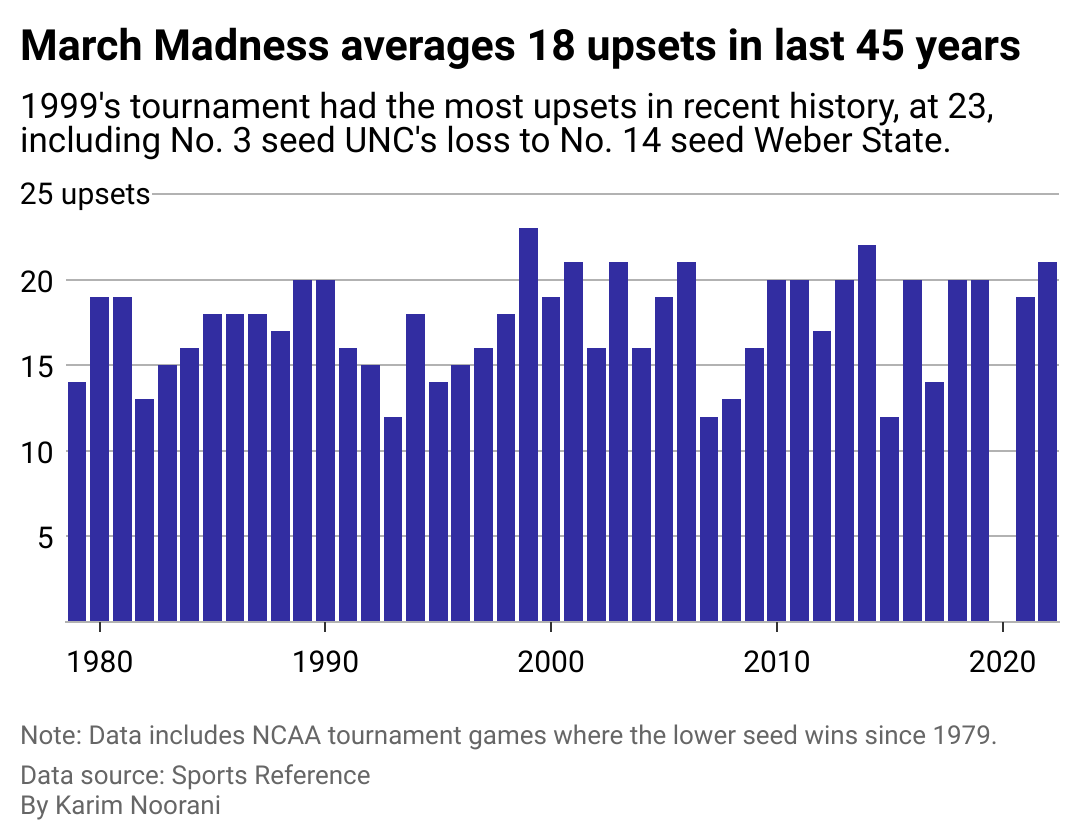
ATS.io
2023 ties for 3rd-highest number of upsets in March Madness history
A column chart showing the number of March Madness upsets since 1979
Upsets have been a factor at every March Madness, but big upsets with seed differences of 10-plus are occurring more frequently. Nineteen of those 40 major upsets have occurred since 2010, and changes within the NCAA may be a factor.
In 2018, the governing body altered its rules around student-athlete transfers, abolishing the requirement that players who change schools must sit out a year. This change allows teams to bring in experienced talent and get immediate results.
New name, image, and likeness rules that took effect in 2021 have also changed the game for schools’ recruiting efforts, as students can choose—or transfer to—the programs that provide the best opportunities to capitalize on their talents financially.
Gameplay is also evolving, with smaller, faster teams finding success on the perimeter of the court against taller teams that rely on their size to dominate in the paint.
Focus on Sport // Getty Images
#10. Richmond beats Syracuse (1991)
Head coach Jim Boeheim of the Syracuse Orangemen talks with an official.
– Seeding difference: 13
– SRS difference: 15.29
– Final score: 73-69
Richmond made history in the first round of the 1991 tournament when they became the first #15 seed to topple a #2 seed.
Even though Syracuse had won the Big East easily, they didn’t show up for this game. The Spiders led the entire time, and though the Orange got close in the final two minutes, a missed 3-point shot and a botched rebound put Richmond junior Curtis Blair on the free-throw line, and he sank the game-clincher.
Richmond’s Cinderella story was short-lived—they lost to #10 seed Temple in the next round, 77-64.
Al Bello // Getty Images
#9. Coppin State beats South Carolina (1997)
David Houston and Fred Warnick of the Coppin Eagles celebrate their win.
– Seeding difference: 13
– SRS difference: 16.30
– Final score: 78-65
A small, historically Black university in West Baltimore, Maryland, relatively unknown Coppin State embodied the very nature of a Cinderella team when it took on the SEC regular-season champions. South Carolina, considered a Final Four team, may have thought this would be an easy win, but the Eagles deemed it at least an even match. They’d played plenty of bigger programs, and just making the Big Dance required two overtime wins in the Mid-Eastern Athletic Conference tournament.
The score was a tie at halftime, but the Gamecocks pulled ahead in the second half. The Eagles clawed back, took the lead with 6:12 remaining, and dominated the rest of the game to become the first MEAC team to win a tournament game. Coppin State’s Danny Singletary and Antoine Brockington were the game’s top scorers with a combined 42 points, while South Carolina star Larry Davis was held to just one field goal—which he didn’t make until the final minute.
The Eagles’ Cinderella story ended in the next round when a huge comeback stalled, and they lost by 1 point to #10 seed Texas. In 2022, ESPN released a one-hour documentary called “On & Coppin” that looked at the Eagles’ season and stunning tournament win.
Andy Hancock // Getty Images
#8. Oral Roberts beats Ohio State (2021)
Oral Roberts University players celebrate upsetting Ohio State University in overtime.
– Seeding difference: 13
– SRS difference: 16.52
– Final score: 75-72, OT
The first round of the 2021 tournament had seven upsets—the biggest being #15 Oral Roberts’ takedown of #2 Ohio State in overtime.
The Golden Eagles did have Max Abmas, the top scorer in Division I, with 24.2 points per game. However, teammate Kevin Obanor bested him here with 30 points to Abmas’ 29. The Buckeyes didn’t help themselves with 16 turnovers to the Golden Eagles’ six. Ohio State also made just five of 23 attempted 3-pointers—including two misses in the final seconds that could have sent the game into double overtime.
After an 81-78 win over #7 seed Florida in which Obanor and Abmas combined for 54 points, Oral Roberts almost upset its way into the Elite Eight but lost to #3 seed Arkansas 72-70.
Jamie Sabau // Getty Images
#7. Saint Peter’s beats Kentucky (2022)
St. Peter’s Peacocks players celebrate after defeating the Kentucky Wildcats.
– Seeding difference: 13
– SRS difference: 17.94
– Final score: 85-79, OT
Kentucky was a Final Four favorite—about 1 in 3 brackets had the #2 seed winning the East Region—but went down in the first round to a team that had not won in its first three NCAA tournament appearances.
The game was tight throughout, with 16 ties and 13 lead changes. Saint Peter’s was down six with three minutes left, but they rallied, took the lead, and later tied it with 21 seconds left, forcing overtime. The Wildcats missed five free throws in the extra period—they made just 65.7% all game—which opened the door for the Peacocks to take the win.
Saint Peter’s magical tournament run didn’t end there—the team took down #7 seed Murray State 70-60 and #3 seed Purdue 67-64, becoming the first #15 seed to get into the Elite Eight, where they lost 69-49 to eventual national finalist North Carolina.
Michael Macor // Getty Images
#6. Santa Clara beats Arizona (1993)
Santa Clara basketball Coach Dick Davey during his first year as the head of the schools men’s basketball program.
– Seeding difference: 13
– SRS difference: 19.09
– Final score: 64-61
With a roster full of first-year students—including future two-time NBA MVP Steve Nash—Santa Clara’s chances against powerhouse Arizona looked slim. The Wildcats seemed to wrap up the game early, going on a 25-0 run to take a 46-33 lead with 15:26 remaining.
However, Arizona star and future NBA player Chris Mills got into foul trouble and was benched for the next 10 minutes. Even with five other future NBA players, including Damon Stoudamire and Ray Owes, the Wildcats couldn’t shoot or rebound against the Broncos, who went ahead 54-53 with 2:45 left.
With 31 seconds left, Nash hit two free throws—the first of six—to extend the Santa Clara lead to 5 points. Though Mills hit a 3-pointer with eight seconds left to cut the Broncos’ lead to three, and Nash and Kevin Dunne missed four free throws, Stoudamire’s 3-point attempt before the buzzer failed to fall Arizona’s way.
It marked the second time a #15 seed sent a #2 seed home.
Brian Bahr // Getty Images
#5. Hampton beats Iowa State (2001)
Martin Rancik of the Iowa State Cyclones crouches down on the court after losing as the Hampton Pirates celebrate.
– Seeding difference: 13
– SRS difference: 19.56
– Final score: 58-57
In their first appearance at the Big Dance and just sixth year as a Division I team, Hampton earned the honor of being the fourth #15 seed to beat a #2 seed. Tarvis Williams led the Pirates to victory with 16 points, 13 rebounds, and six blocks.
Hampton was ahead at halftime 31-27, but Iowa State came back in the second half to build an 11-point lead. The Pirates held the Cyclones scoreless in the last seven minutes, which allowed Hampton to seize the moment.
Williams, sitting on four fouls, scored the go-ahead basket with just 6.9 seconds on the clock. Future pro Jamaal Tinsley’s last-second layup attempt refused to go in.
Dilip Vishwanat // Getty Images
#4. Middle Tennessee beats Michigan State (2016)
Jaqawn Raymond of the Middle Tennessee Blue Raiders celebrates in the game against the Michigan State Spartans.
– Seeding difference: 13
– SRS difference: 19.93
– Final score: 90-81
Michigan State went into this game as one of the tournament favorites—22.3% of entries in ESPN’s annual tournament challenge picked the Spartans to win the event—but #15 seed Middle Tennessee broke those 2.9 million brackets and more in its commanding upset.
The Blue Raiders led 15-2 and never trailed, and their entire starting lineup contributed double-digit points. As they had all season, the balanced quartet of Reggie Upshaw (21 points), Giddy Potts (19), Perrin Buford (15), and Darnell Harris (15) led the way, and Jaqawn Raymond added 11.
The Blue Raiders defense also rendered Spartans star senior Denzel Valentine ineffective. The Associated Press Player of the Year and future NBAer had just 13 points, 6 points shy of his average, on 5-of-13 shooting and a game-high six turnovers, one short of his career high.
Doug Pensinger // Getty Images
#3. Norfolk State beats Missouri (2012)
Kyle O’Quinn and Brandon Wheeless celebrate after they won 86-84 against the Missouri Tigers.
– Seeding difference: 13
– SRS difference: 23.45
– Final score: 86-84
It had been 11 years since a #15 seed had taken down a #2 seed when Norfolk State did so in a nailbiter against the Big 12 Conference tournament champions. In their Division I debut, the Spartans hung with Missouri’s four-guard offense to end the first half tied.
The Spartans used their size to out-rebound the Tigers 35-23, including a 14-6 advantage on the offensive glass. Norfolk State also made 10 of 19 attempted 3-pointers and shot 54.2% overall. Future NBA player Kyle O’Quinn led the way with 26 points and 14 rebounds, and Pendarvis Williams and Chris McEachin added four threes and 20 points apiece.
Missouri had a chance to win it at the buzzer, but the Spartans played point guard Phil Pressey perfectly, and his 3-point attempt bounced off the back of the rim as time expired.
Streeter Lecka // Getty Images
#2. UMBC beats Virginia (2018)
The UMBC Retrievers bench reacts to their 74-54 victory over the Virginia Cavaliers.
– Seeding difference: 15
– SRS difference: 24.22
– Final score: 74-54
Before this game, many people had never heard of the University of Maryland, Baltimore County, but the Retrievers made history as the first #16 seed to take down a #1 seed.
Virginia, the top team in the nation, had been dominant all season, holding opponents to 53.4 points a game, yet UMBC outscored them 53-33 in the second half alone. The Retrievers commandeered 3-point territory, making 12-of-24 while holding the Cavaliers to 4-of-22.
The UMBC starting lineup included K.J. Maura, who at 5-foot-8, was one of the smallest players in the tournament. His energy and speed helped four of UMBC’s starters score in double digits, including Jairus Lyles, the game’s leading scorer with 28.
Jay LaPrete // Getty Images
#1. Fairleigh Dickinson beats Purdue (2023)
Players from the Fairleigh Dickinson Knights celebrate their win over the Purdue Boilermakers.
– Seeding difference: 15
– SRS difference: 27.20
– Final score: 63-58
FDU wasn’t even supposed to be at the Big Dance, let alone become the Cinderella story. The Knights lost the Northeast Conference tournament championship game to Merrimack, but the Warriors, still transitioning from Division II, could not go because of NCAA rules. That sent Fairleigh Dickinson to the First Four, where a victory gave them entry into the full tournament.
This matchup wasn’t just David and Goliath on paper—the Knights had the shortest team in Division I, and Purdue’s star was 7-foot-4 center Zach Edey. While FDU was ahead by 1 point at halftime, the Boilermakers established a 47-41 lead with 11:41 to go.
FDU outscored Purdue 22-11 the rest of the way, though the Knights’ victory wasn’t guaranteed until Demetre Roberts made two free throws with seven seconds to play. The stats show how poorly the Boilermakers dealt with the pressure, as they shot only 35.8% from the field and had 16 turnovers, twice as many as Fairleigh Dickinson.
The Knights played #9 seed Florida Atlantic close in the second round but faded down the stretch, losing 78-70 to the eventual national semifinalists.
Story editing by Mike Taylor. Copy editing by Robert Wickwire. Photo selection by Clarese Moller.
This story originally appeared on ATS.io and was produced and
distributed in partnership with Stacker Studio.
